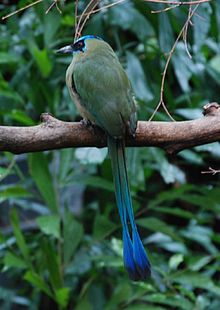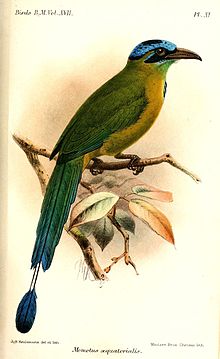- Blue-crowned Motmot
-
Blue-crowned Motmot 
In Tobago Conservation status Scientific classification Kingdom: Animalia Phylum: Chordata Class: Aves Order: Coraciiformes Family: Momotidae Genus: Momotus Species: M. momota Binomial name Momotus momota
(Linnaeus, 1758)The Blue-crowned Motmot, Momotus momota, is a colourful near-passerine bird found in forests and woodlands of eastern Mexico, Central America, northern and central South America, and Trinidad and Tobago. As presently defined, it includes several taxa that possibly should be recognized as valid species, including the Andean Motmot (or Highland Motmot), Momotus aequatorialis.
 Sub-adult at El Paso Zoo, Texas, USA
Sub-adult at El Paso Zoo, Texas, USA
 Highland Motmot (M. m. aequatorialis), illustration by Keulemans, 1892
Highland Motmot (M. m. aequatorialis), illustration by Keulemans, 1892
Contents
Description and behavior
Like most of the Coraciiformes, motmots nest in tunnels in banks, laying about three or four white eggs.
The Blue-crowned Motmot is 38–48 cm (15-19 in) long, depending on race. Nominate M. m. momota may weigh as little as 77 grams (2.7 oz), while the Highland Motmot may weigh up to 175 grams (6.2 oz).[1] The tail is very long with a bare-shafted racket tip. The upperparts are green, shading to blue on the lower tail, and the underparts are green or rufous depending on subspecies.
In all except the entirely blue-crowned subspecies coeruliceps, the central crown is black and surrounded by a blue band. There is a black eyemask, and the nape of momota is chestnut. The call is a low owl-like ooo-doot, although there are variations depending on the subspecies involved.
These birds often sit still, and in their dense forest habitat can be difficult to see, despite their size. They eat small prey such as insects and lizards, and will also regularly take fruit.
Taxonomy
As presently defined, it is likely that the Blue-crowned Motmot includes several species level taxa. Especially the Andean (Highland) Motmot, Momotus aequatorialis (Gould, 1858), is frequently considered a separate species, but this treatment is no longer adopted here, following SACC (2005), which noted that the published evidence for treating it as a separate species is weak, but also hoped their decision would stimulate further research on the taxonomy of the M. momota complex. In addition to the Andean Motmot, several major groups have been identified: Amazonian Motmot (momota group; found in central and northern South America), Whooping or Tawny-bellied Motmot (subrufescens group; found in north-western South America and eastern Panama), Blue-diademed or Lesson's Motmot (lessonii group; found in most of Central America and eastern Mexico) and the 'true' Blue-crowned Motmot (coeruliceps; found in north-eastern Mexico). Additionally, the taxon from Trinidad and Tobago, misleadingly named bahamensis (there are no motmots in the Bahamas), is distinctive, and possibly worthy of species recognition. Based on measurements, plumage and voice most of these group were considered to be species by Stiles (2009). The only exception was coeruliceps, which was beyond the scope of that study.
Gallery
-
M. momota bahamensis in Tobago.
-
M. momota lessonii in Costa Rica.
Notes
References
- BirdLife International (2006). Momotus momota. 2006. IUCN Red List of Threatened Species. IUCN 2006. www.iucnredlist.org. Retrieved on 11 May 2006.
- Hilty, Birds of Venezuela, ISBN 0-7136-6418-5
- Stiles and Skutch, A guide to the birds of Costa Rica ISBN 0-0814-9600-4
- Stiles, F. G. (2009). A review of the genus Momotus (Coraciiformes:Momotidae) in Northern South American and adjacent areas. Ornitología Colombiana 8: 29-75.
External links
- Blue-crowned Motmot videos, photos & sounds on the Internet Bird Collection
- Blue-crowned Motmot at Animal Diversity Web
Categories:- IUCN Red List least concern species
- Momotidae
- Birds of South America
- Birds of the Guianas
- Birds of Guyana
- Birds of Mexico
- Birds of El Salvador
- Birds of Central America
- Birds of Trinidad and Tobago
- Birds of Colombia
-
Wikimedia Foundation. 2010.




